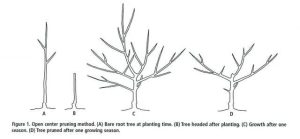Are you overwhelmed by the idea of pruning your landscape? You’re not alone. For many of us, learning to prune properly is an on-going experience. Haven’t we all witnessed the results of an improper cut the next season? I certainly have. So if you’re like many gardeners, pruning may be the task about which you feel most uncomfortable.
On Saturday, February 7th, at the Tuolumne Master Gardener Open Garden Day, there will be a fruit-tree, rose bush pruning and soil preparation demonstrations. This will be held at the UCCE Tuolumne Master Gardener Demonstration Garden, located at 251 S. Barretta Street, Sonora. The Garden will be open from 10:00 a.m. to 1:00 p.m. Presentations start at 10:30 a.m.
There will be three presentations. Two sessions are hands-on clinics, meaning that you will have a chance to actually do some pruning. Please bring gloves, hand clippers and loppers, a hat and water. The third presentation is on soil preparation for spring vegetable planting. Master Gardeners will conduct these demonstrations and will also be available to answer your questions.
In general, the best time to prune most plants is during late winter or early spring before growth begins. The least desirable time is immediately after new growth develops in the spring. A great amount of food stored in roots and stems is used in developing new growth. This food should be replaced by new foliage before it is removed. If not, considerable dwarfing of the plant may occur.
Proper pruning will improve the quality of flowers, fruit, foliage and stems. It will also enhance the beauty of almost any landscape tree or shrub. After removal of dead branches you will be rewarded with the appearance of neatness and tidiness.
Many California natives are highly flammable under drought conditions and in summer and fall. When used in the landscape, natives should be well-spaced and pruned of deadwood to reduce their ability to carry fire. When we remove the dead wood from our native manzanitas they look so much better and their dark red trunks seem even more dramatic.
The care of your pruning tools is very important in order to make proper cuts. Clean and oil tools regularly, including wiping an oily cloth on blades and other metal surfaces. Keep cutting edges sharp; several passes with a good oil stone will usually suffice. Paint, varnish or regularly treat wooden handles with linseed oil.
Use tools properly. Don’t twist or strain pruners or loppers. Keep the branch to be cut as deeply in the jaws and near the pivot as possible. Don’t cut wires with pruning tools.
You may be asking which branches to cut first in your landscape trees and shrubs. The easiest way to see a deciduous (sheds its leaves in the autumn) tree’s framework is in the winter. First cut branches that are broken, dead or diseased. Branches growing straight down, straight up or directly into another branch can also be removed. If there are suckers around the bottom of the trunk, remove them. Remove small branches before larger branches are selected. Next, choose the structure or scaffolding branches, usually 3 or 4, to be evenly distributed around the trunk. Pruning during the first 4 or 5 years establishes framework and is called training. The results of your labor will be enjoyed for many future seasons.
For information about Tuolumne Master Gardener Events, call the University of California Cooperative Extension office at 533-5695 or the Master Gardener Hotline at 533-5912. Hopefully, we will see you this Saturday, February 7th at the Tuolumne Master Gardener Demonstration Garden located on 251 So. Barretta Str., in Sonora.


